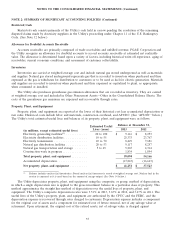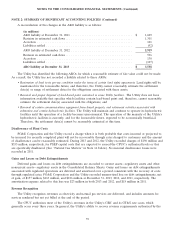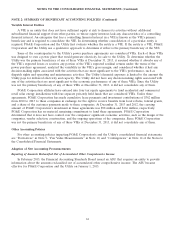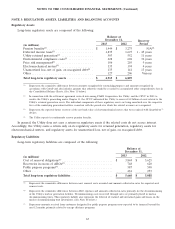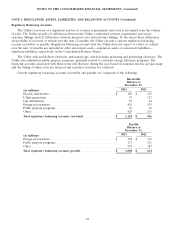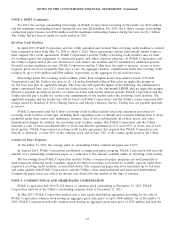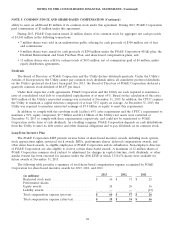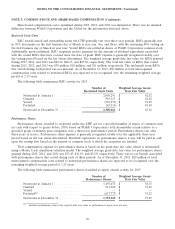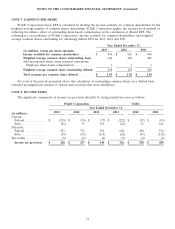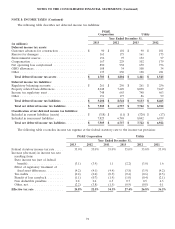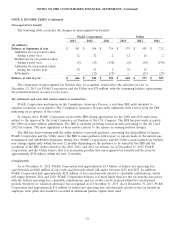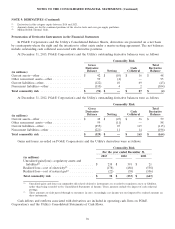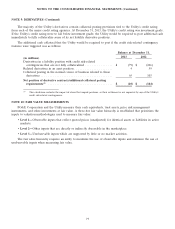PG&E 2013 Annual Report Download - page 73
Download and view the complete annual report
Please find page 73 of the 2013 PG&E annual report below. You can navigate through the pages in the report by either clicking on the pages listed below, or by using the keyword search tool below to find specific information within the annual report.NOTES TO THE CONSOLIDATED FINANCIAL STATEMENTS (Continued)
NOTE 4: DEBT (Continued)
For 2013, the average outstanding borrowings on PG&E Corporation’s revolving credit facility was $214 million
and the maximum outstanding balance during the year was $260 million. For 2013, the Utility’s average outstanding
commercial paper balance was $542 million and the maximum outstanding balance during the year was $1.1 billion.
The Utility did not borrow under its credit facility in 2013.
Revolving Credit Facilities
In April 2013, PG&E Corporation and the Utility amended and restated their revolving credit facilities to extend
their termination dates from May 31, 2016 to April 1, 2018. These agreements contain substantially similar terms as
their original 2011 credit agreements. PG&E Corporation’s and the Utility’s revolving credit facilities may be used
for working capital, the repayment of commercial paper, and other corporate purposes. At PG&E Corporation’s and
the Utility’s request and at the sole discretion of each lender, the facilities may be extended for additional periods.
Provided certain conditions are met, PG&E Corporation and the Utility have the right to increase, in one or more
requests, given not more frequently than once a year, the aggregate lenders’ commitments under the revolving credit
facilities by up to $100 million and $500 million, respectively, in the aggregate for all such increases.
Borrowings under the revolving credit facilities (other than swingline loans) bear interest based, at PG&E
Corporation’s and the Utility’s election, on (1) a London Interbank Offered Rate plus an applicable margin or
(2) the base rate plus an applicable margin. The base rate will equal the higher of the following: the administrative
agent’s announced base rate, 0.5% above the federal funds rate, or the one-month LIBOR plus an applicable margin.
Interest is payable quarterly in arrears, or earlier for loans with shorter interest periods. PG&E Corporation and the
Utility also will pay a facility fee on the total commitments of the lenders under the revolving credit facilities. The
applicable margins and the facility fees will be based on PG&E Corporation’s and the Utility’s senior unsecured debt
ratings issued by Standard & Poor’s Rating Services and Moody’s Investor Service. Facility fees are payable quarterly
in arrears.
PG&E Corporation’s and the Utility’s revolving credit facilities include usual and customary provisions for
revolving credit facilities of this type, including those regarding events of default and covenants limiting liens to those
permitted under their senior note indentures, mergers, sales of all or substantially all of their assets, and other
fundamental changes. In addition, the revolving credit facilities require that PG&E Corporation and the Utility
maintain a ratio of total consolidated debt to total consolidated capitalization of at most 65% as of the end of each
fiscal quarter. PG&E Corporation’s revolving credit facility agreement also requires that PG&E Corporation own,
directly or indirectly, at least 80% of the common stock and at least 70% of the voting capital stock of the Utility.
Commercial Paper Programs
At December 31, 2013, the average yield on outstanding Utility commercial paper was 0.26%.
In January 2014, PG&E Corporation established a commercial paper program. PG&E Corporation will treat the
amount of its outstanding commercial paper as a reduction to the amount available under its revolving credit facility.
The borrowings from PG&E Corporation and the Utility’s commercial paper programs are used primarily to
fund temporary financing needs. Liquidity support for these borrowings is provided by available capacity under their
respective revolving credit facilities, as described above. The commercial paper may have maturities up to 365 days
and ranks equally with PG&E Corporation’s and the Utility’s other unsubordinated and unsecured indebtedness.
Commercial paper notes are sold at an interest rate dictated by the market at the time of issuance.
NOTE 5: COMMON STOCK AND SHARE-BASED COMPENSATION
PG&E Corporation had 456,670,424 shares of common stock outstanding at December 31, 2013. PG&E
Corporation held all of the Utility’s outstanding common stock at December 31, 2013.
In May 2013, PG&E Corporation entered into a new equity distribution agreement providing for the sale of
PG&E Corporation common stock having an aggregate gross sales price of up to $400 million. As of December 31,
2013, PG&E Corporation had sold common stock having an aggregate gross sales price of $395 million and had the
67


